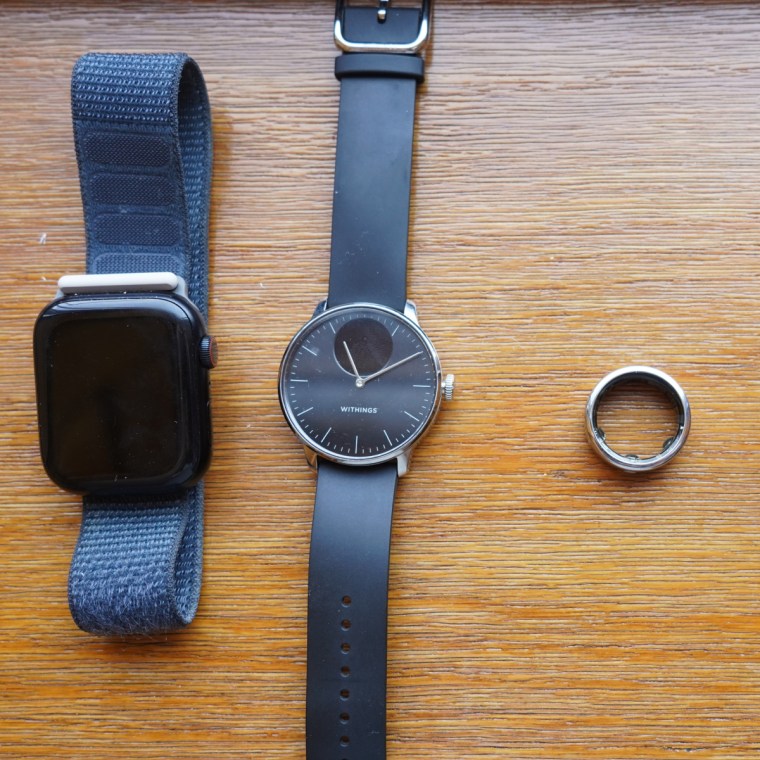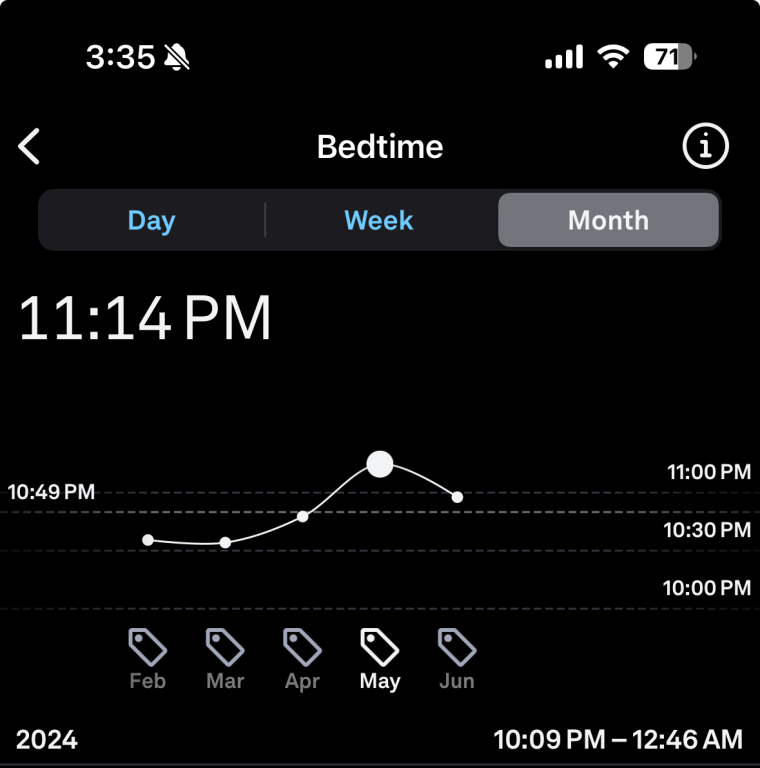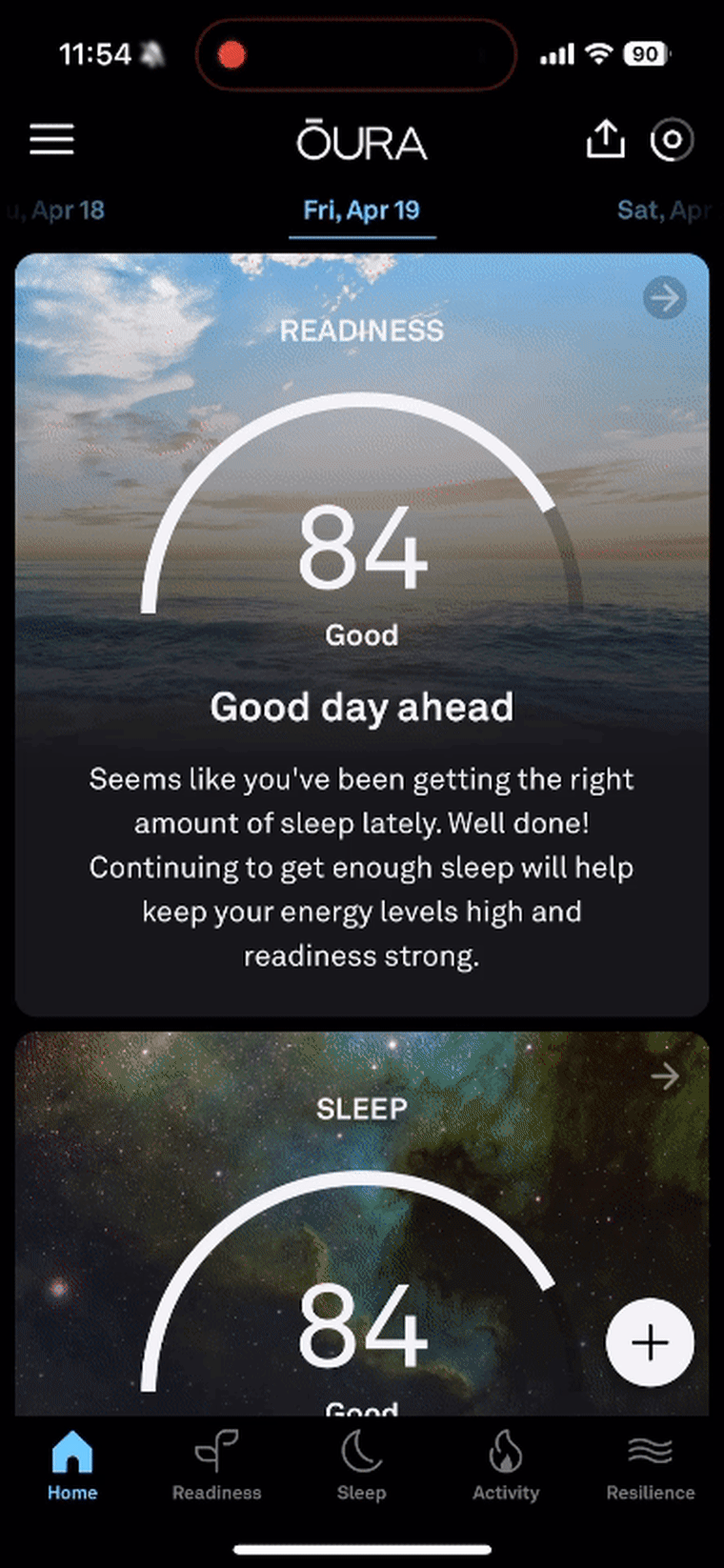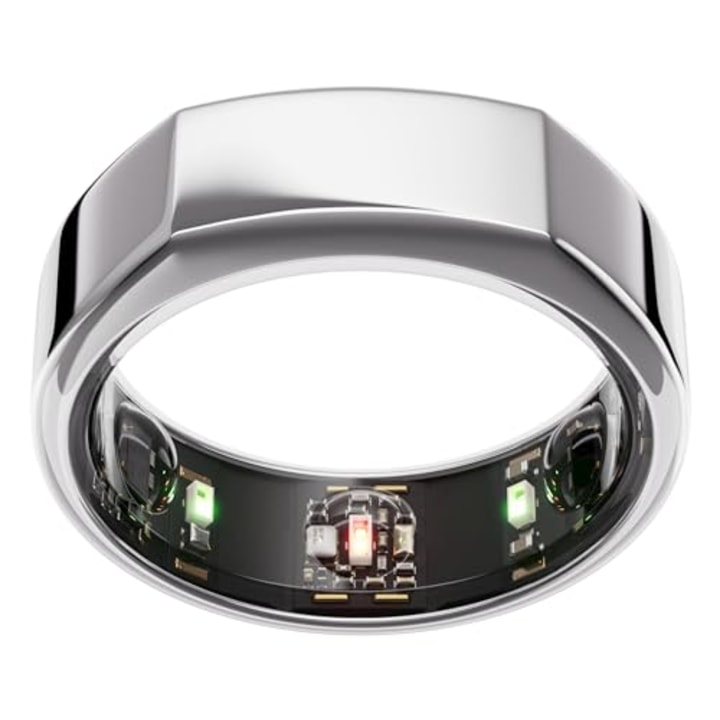I love my fitness trackers, but not everyone enjoys a bulky watch on their wrist. As a tech reporter, I often come to work with a different watch on my wrist, and my co-workers almost always deem them “ugly” or “too big.” I get it: most trackers are not subtle.
The Oura Ring is an exception: it’s a health tracker disguised as a metal ring. I wore it for over four months (after the brand sent me a sample to try out), and think it’s a great alternative for anyone who hates chunky watches. But it’s not a do-it-all wearable — it won’t replace your smartwatch. Read on to learn what you should know before buying one.
SKIP AHEAD How I tried the Oura Ring | My experience with the Oura Ring | Who is the Oura Ring best for?
What is the Oura Ring?
Oura Ring
The Oura Ring ($299) comes in two designs: Heritage, which has flat accents, and Horizon, which is a standard, uniform circle (and costs $50 more). Both are made of titanium on the outside and plastic on the inner finish. You can choose from six different finishes (two are exclusive to the Horizon design).
The ring tracks a plethora of health metrics like heart rate, blood oxygen, skin temperature and daily steps. It can also automatically detect and log workouts like running, cycling, strength and training. The app keeps a history of all your data, so you can see changes and trends over days, weeks and months.
The ring technically does not require a subscription, though without one, you get a very limited amount of data: just daily scores for sleep, activity and readiness, according to the brand. A subscription, which costs $5.99 a month or $69.99 a year, gives you access to much more data, including detailed sleep analysis, blood oxygen sensing, stress insights, resilience scores, dynamic activity goals and weekly, monthly, quarterly and yearly reports. (Oura provided me a 12-month subscription to use during my testing.)
Display: N/A | Weight: 4-6 grams | Battery life: Up to 7 days | Built-in GPS: N/A | Sleep tracking: Yes (including naps) | Heart-rate monitor: Yes, with EKG | Water resistance: Yes, up to 100 meters (up to 12 hours) | Works best with: Oura app (iPhone or Android)
How I tried the Oura Ring

Before I could test the Oura Ring, I had to find my ring size. Customers receive a free sizing kit as part of any ring purchase before your tracker ships — I used the sizing kit to find the most comfortable fit for my right-hand ring finger, then updated my order. Oura recommends wearing the ring on your index finger with the sensor bumps against the underside of your finger for optimal performance. Middle and ring fingers work, too, according to the brand.
I tested Oura Ring for about four months. For the first three months, I wore it all the time, including while running, biking and at the gym (except when weight lifting). For the fourth month, I wore it solely at night for sleep tracking.
When sleep testing it, I wore the Oura Ring and one other sleep tracking device like the Apple Watch Series 9 ($399), Apple Watch SE ($249) and Withings Scanwatch Light ($249) to compare the results.
My experience with the Oura Ring
The Oura Ring is part of a small but growing category of ring-shaped health trackers, a few competitors being the Ultrahuman Ring Air ($349), RingConn Smart Ring ($279) and Evie Ring ($269).
After wearing it for four months, it’s not for me (I don’t find rings very comfortable), but it could be a good fit for your needs. It’s a very accurate health and sleep tracker, delivering detailed stats, trends data and a mostly hands-off experience in a much smaller size than something like an Apple Watch Series 9 or Samsung Galaxy Watch 6 ($299).
Below, I outline my experience in more detail and what to know before buying one.
What I like
Sleep tracking
The Oura Ring was more accurate for sleep tracking compared to other wearables I used at the same time. For example, when I wake up in the middle of the night, the Oura Ring would correctly track a brief awake period. If I woke up at 5:45 a.m. but stayed in bed scrolling on my phone until 6:30 a.m., the Oura Ring would aso correctly denote this as ‘awake time’. Other wearables I’ve tried don’t always get this right.

One standout feature I found useful (after a few months of wear) was its sleep trends function. With Sleep Trends, I can see changes in data points like my bedtime, time in bed and wake-up time, things I have more control over than stats like deep sleep and restfulness. I try to be in bed by 10:15 p.m. and hope to be asleep by 10:30 p.m. Using sleep trends, I saw that I fell asleep (on average) at 10:34 p.m. in March, but that changed to 11:14 p.m.in May (yikes).
Health tracking
The Oura Ring’s accurate tracking extends to general health stats like daily steps, resting heart rate and body temperature. I got sick with a cold while testing the ring, and was impressed with how it responded.

I sleep poorly when I first start to feel sick. On one particular morning, the Oura app asked me how I was feeling (it automatically detected my increased body temperature). I answered a few prompts and was prompted to enter rest mode. Rest mode paused my daily fitness and health goals (including notifications).
As someone who has gotten many reminders from other fitness trackers to stand up, go for a walk, or hit my fitness goals while sick, I appreciate Oura’s automatic rest mode and focus on recovery.
Automatic workout detection
The Oura Ring automatically detects when you start a workout. It doesn’t ring or buzz at you in the moment, but when you open the app later, it will ask you to double check and confirm all the workouts it detected. It’s a great approach for minimalists who don’t want to start and stop a walk to record a workout, but it still accounts for basic stats like exercise duration, heart rate and calorie burn.
It’s not the most accurate or useful fitness tracker, however. More on that below.
Drawbacks to keep in mind
No half sizing
I am not a ring person, and the Oura Ring didn’t change that. The only thing I put on my fingers is my wedding band, and that’s less than half the height and thickness of the Oura Ring.
It doesn’t help that the Oura Ring is only available in full sizes. This is not unique to Oura: no smart rings currently on the market are available in half sizes.
My right ring finger is a size 7.5. Using Oura’s ring sizing kit, I found size 8 the most comfortable. But that meant that the ring spun around on my finger; I had to manually realign the sensors often. Since it has a slightly roomy fit on my finger, water would get stuck under the ring everytime I washed my hands — I had to take off the ring if I wanted to actually feel dry.
No live fitness stats
I’m an avid runner and a cyclist. I like to track my heart rate, pace and mileage in real time as I exercise. The Oura Ring doesn’t have a screen, so it can’t show me the same on-wrist data as something like an Apple Watch or Garmin. The Oura app doesn’t have live tracking either.
Inconsistent GPS data
I do almost all of my runs outside, and like to look at my pace, mileage and route afterwards, especially if I am running in a new place. On multiple occasions, I noticed inconsistent map data on the Oura app after my runs. For example: The Oura app would show that I only ran halfway around a nearby park instead of all the way around.
I asked representatives from Oura about the inconsistent map data, and they recommended I turn the location tracking in my settings to “always on” to assure accuracy when recording workouts. After reading some support articles online via their site, I also began “starting” and “stopping” my runs manually via the app — instead of relying on automatic detection — through the “record workout HR” function.
To be clear: Oura’s running metrics were accurate before I changed these settings — things like duration, distance, pace and heart rate were similar to my Apple Watch SE’s data, which I wore to compare against. It was its map display and settings that were giving me some issues. Despite manually recording my workouts via the app, as well as implementing Oura’s recommendation for always keeping my location services on, I didn’t see an improvement in the app data.
I don’t find this surprising given that the Oura Ring relies on your phone’s GPS while many of the best fitness trackers have their own GPS built in. Something like the Garmin Forerunner 165 ($249) might be a better choice if you value consistent map and route data for outdoor fitness.
Subscription price
The Oura Ring all but requires a subscription to be worthwhile. Without a subscription, you can only see daily scores for sleep, activity and readiness, according to the brand. With it, you get full data history, detailed sleep analysis, advanced temperature monitoring, blood oxygen sensing and resilience data (complete list of membership benefits here). It costs $5.99 a month or $69.99 a year — this is on top of $299 for the ring. That’s pretty steep, especially considering smartwatches like the Apple Watch Series 9 and Samsung Galaxy Watch 6 track similar data and don’t require a subscription.
Who is the Oura Ring best for?
The Oura Ring is best for anyone who doesn’t want to wear something bulky on their wrist, but still wants to track some health and fitness habits. It delivers very accurate sleep and health data, and doesn’t require much input from the wearer. It has enough battery life to last about a week, and charges relatively painlessly with the included slim dock.
It’s not a good fit for anyone who relies on live exercise stats like runners or cyclists. It’s also a bit pricey, especially considering the subscription — though it does pass as jewelry, and $300 for a ring that’s also a health tracker doesn’t sound as bad. And if you’re like me and just don’t find rings comfortable, this one won’t change your mind.
Why trust NBC Select?
I’m a reporter at NBC Select who covers technology and fitness including guides to fitness trackers, running shoes and workout earbuds. I tried the Oura Ring over four months after the brand sent me a model to try out. I tracked my everyday stats, sleep and exercise using the ring, and compared it to other wearables at similar price points.
Catch up on NBC Select’s in-depth coverage of personal finance, tech and tools, wellness and more, and follow us on Facebook, Instagram, Twitter and TikTok to stay up to date.







